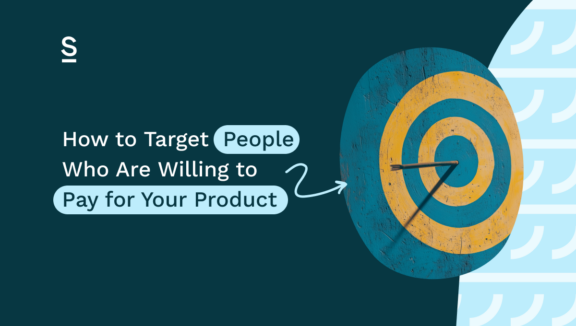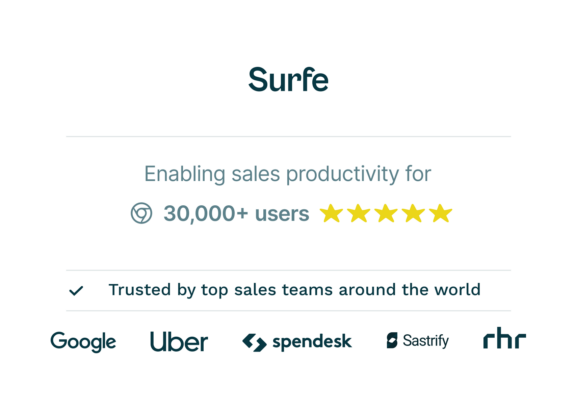How to Target People Who Are Willing to Pay for Your Product

What’s your fantasy purchase?
A Birkin bag? A Porsche? An island?
Here’s the thing. Wanting – and even needing – these items isn’t the same as being able to pay for them. Maybe you do have a couple of million stored away somewhere and you’re working in sales for fun, but if you don’t these purchases might have to stay firmly in fantasy-land (for now, obviously).
The same goes for the people you’re targeting during your day-to-day. It’s all very well connecting with people who would like your product and understand the need for it – but if they don’t have the budget, you’re wasting your time. Sorry.
67% of lost sales are due to poor lead qualification – and every minute you spend on a poorly qualified lead is a minute you could be spending on another one. Identifying high-quality leads can reduce wasted effort and improve conversion rates – and we’re going to talk about how to do exactly that today:
- Understand Your Ideal Customer Profile (ICP)
- Leverage Data and Insights
- Invest in Lead Nurturing
- Align Sales and Marketing Teams
After reading, you’ll be so good at your job that you might be able to afford your fantasy purchase after all. We’re sure you don’t need any more persuading than that – let’s get going.
Understand Your Ideal Customer Profile (ICP)
First up, you need to get clear about who you’re selling to. This involves building out an Ideal Customer Profile (ICP), which is basically a very detailed description of the type of customer most likely to buy your product.
Let’s take a closer look at how you might define your ICP:
- Start off by analyzing your current paying customers: look for commonalities in industry, company size, what type of roles make the decisions, and so on and so forth.
- Next, segment your current customers by behavior. Take a look at how they interact with your product: for example, do they tend to request demos early on? Do they all spend a significant amount of time on your website?
- Consider their willingness to pay: companies with minimal revenue or years on from their latest raise might be less willing to pay. You also want to think about common problems these businesses have – and how much they tend to want to solve them. If your product’s a painkiller rather than a vitamin, so to speak, you’re on the money.
Pro tip: you don’t have to do all this using your brain and your brain alone. Use tools like CRMs and lead scoring systems to document and refine your ICP until you hit the nail on the head.
Once you’ve got a detailed description of your dream company down, you need to find businesses – and people – who actually fit the bill. We’d recommend doing that using Surfe – so weird how our own product found its way into this article, right? Surfe lets you use super powerful filtering to build a list of hyper-specific potential customers. You can sort by revenue, headcount, industry, location, and more until you’ve got a list of people just desperate to buy from you. Love it.
Qualify Leads Effectively
Ok, you now know who your ICP is and you’ve used Surfe to build a list of companies or people who fit the bill.
Next up, you need to qualify them. Having a robust qualification system in place is important – to take one example, only 25% of marketing-generated leads are high-quality enough to advance to sales. Without a qualification process, 75% of the leads you’d be working on would be a waste of your time. Ouch.
Key qualifying criteria might be:
- Budget: can they afford your product?
- Authority: are you speaking with the decision-maker?
- Need: does your product solve a critical pain point for them, or is it something they could live without?
- Timeline: are they ready to buy now, or do they need to hold off until a contract ends or they finish raising capital?
A second pro tip: a scoring system (like the BANT example above) can help you evaluate prospects quickly and easily.
Leverage Data and Insights
Whether you’re a numbers person or not, data is your best friend when it comes to working out who’s willing to pay for your product, right now. Let’s take a look at what you should be keeping an eye out for:
- Customer Insights: use analytics tools to track purchasing signals like repeat website visits, content downloads, or demo requests. If someone’s visiting your pricing page a lot or downloading a whitepaper, that’s a very good sign they’re considering a purchase.
- Behavioral Triggers: identify patterns like companies expanding their teams, launching new products, or adopting related tools. Eventually, you’ll have a list of signals that a business may be in the market to buy from you.
You can also use sales tools to gather actionable insights on prospects that might point you in the right direction. Think data enrichment APIs, CRMs, and social listening tools. Used together, these can tell you a lot about your prospects and what they’re thinking and feeling about your product.
Targeting Through Personalized Outreach
Ok, so by now you know who you’re targeting, they’re qualified, and they’re showing signs of being ready to buy soon, if not now.
Next up – what on earth do you say to them?
This is where personalization comes in. Generic outreach emails just don’t cut it in today’s day and age – personalize your messaging, and you’ll see a 29% open rate and a 41% click-through rate. You don’t need to be an email expert to tell us that those are pretty sweet.
Strategies for Personalization
Sorry to break it to you, but ‘Dear [FIRST NAME]’ doesn’t count as personalization anymore. Instead, you need to go deeper:
- Reference the prospect’s specific challenges or goals (which you’ve identified in the ICP-building stage)
- Tailor messaging based on their industry and role (which you found out using Surfe)
- Highlight relevant case studies or testimonials (choose these based on online behavior trends like downloading content
A third pro tip: use email for formal outreach, LinkedIn for a casual connection or DM, and phone calls for seniors and decision-makers, who often prefer direct communication.
Invest in Lead Nurturing
In an ideal world, you’d reach out once and the prospect would fall at your feet, swooning with the prospect of buying from you.
In the real world, this might happen occasionally – but more often than not, you’ll need to nurture your people a bit before they’re ready to move forward. The more informed a prospect feels, the more willing they’ll be to pay for your product when it comes to crunch time. In fact, nurtured leads produce a 20% increase in sales opportunities. Not to be sniffed at.
Nurturing leads is a delicate dance, though. Here’s how to get it right:
- Send them educational content – think reports or whitepapers – to build trust and demonstrate value
- Set up email drip campaigns for those not quite ready to buy yet. It’ll keep your product top of mind and educate them at the same time
- Follow up consistently but strategically. You want to aim for cheerful persistence – 80% of sales require 5+ follow-ups
Fourth pro tip (really spoiling you here, aren’t we): thinking just in terms of nurture/not nurture can hold you back. Segment your leads based on how ready they are to buy your product, and tailor your efforts accordingly for best results.
Align Sales and Marketing Teams
Only 27% of MQLs are typically qualified – and often that comes from sales and marketing not communicating with each other properly. We’d recommend a regular meeting – or at least a Slack channel – where you can:
- Share ICP insights between teams
- Agree on a clear lead-scoring system
- Collaborate on content creation to keep messaging consistent
Really, marketing and sales should be best friends – as a wise man (probably) said (somewhere, at some point) the best results come out of the best relationships.
Let’s Wrap It Up!
Follow these steps, and you’ll soon be working with prospects who are excited to hear from you, actually understand the need for your product, and, crucially, are actually willing to pay for your product.
Remember: every new deal is getting you a step closer to your private island. Richard Branson who?

Get ready to find your money makers
All you need to do know is set up some super-specific filtering with Surfe. Just hit the button below.
Faqs About Targeting People Who Are Willing To Pay For Your Product
What Is an Ideal Customer Profile (ICP) and Why Is It Important?
An ICP is a detailed description of the type of customer most likely to buy your product. It’s important to define your ICP because doing so makes sure you focus your time on leads who are a good fit for your product and have the budget to pay for it. Building a solid ICP involves analyzing your existing paying customers, segmenting them by behavior, and understanding their willingness to invest in solving specific pain points.
How Do You Qualify Leads Effectively?
Qualifying leads means determining whether a prospect is a good fit for your product. Use criteria like Budget (can they afford it?), Authority (are you speaking with the decision-maker?), Need (does your product solve a big problem for them?), and Timeline (are they ready to buy now?). Without lead qualification, you risk wasting time on people who will never convert – a double ouch when you consider how else you could’ve been spending that time.
What Data Should You Use to Identify High-Paying Prospects?
Keep an eye on customer insights like repeat visits to your pricing page or content downloads – these are clear buying signals. Track behavioral triggers such as company expansions, new product launches, or tech adoption. Combine tools like CRMs, analytics platforms, and social listening tools to enrich your data. Together, these insights paint a clear picture of who’s likely to pay for your product – right now.
How Can Personalized Outreach Help Target Willing Buyers?
Personalization makes your outreach stand out in a sea of generic emails. Reference the prospect’s challenges, tailor messaging to their role and industry, and highlight relevant case studies. Use email for formal outreach, LinkedIn for casual connections, and phone calls for decision-makers. Personalization boosts open and click-through rates – which means more willing buyers in your pipeline.
Why Is Lead Nurturing Key to Targeting Paying Customers?
Lead nurturing helps to build trust and keeps your product top of mind for prospects who aren’t quite ready to buy. Use educational content like whitepapers, case studies, and strategic follow-ups to guide them along the buyer’s journey. Since 80% of sales require five or more follow-ups, consistent communication is key. Segmenting leads by readiness also ensures you’re targeting the right people at the right time.


